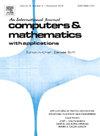Generalized soft finite element method for elliptic eigenvalue problems
IF 2.9
2区 数学
Q1 MATHEMATICS, APPLIED
引用次数: 0
Abstract
The recently proposed soft finite element method (SoftFEM) reduces the stiffness (condition numbers), consequently improving the overall approximation accuracy. The method subtracts a least-square term that penalizes the gradient jumps across mesh interfaces from the FEM stiffness bilinear form while maintaining the system's coercivity. Herein, we present two generalizations for SoftFEM that aim to improve the approximation accuracy and further reduce the discrete systems' stiffness. Firstly and most naturally, we generalize SoftFEM by adding a least-square term to the mass bilinear form. Superconvergent results of rates and for eigenvalues are established for linear uniform elements; is the highest order of convergence known in the literature. Secondly, we generalize SoftFEM by applying the blended Gaussian-type quadratures. We demonstrate further reductions in stiffness compared to traditional FEM and SoftFEM. The coercivity and analysis of the optimal error convergences follow the work of SoftFEM. Thus, this paper focuses on the numerical study of these generalizations. For linear and uniform elements, analytical eigenpairs, exact eigenvalue errors, and superconvergent error analysis are established. Various numerical examples demonstrate the potential of generalized SoftFEMs for spectral approximation, particularly in high-frequency regimes.
椭圆型特征值问题的广义软有限元方法
最近提出的软有限元法(SoftFEM)降低了刚度(条件数),从而提高了整体近似精度。该方法在保持系统矫顽力的前提下,从有限元刚度双线性方程式中减去一个最小平方项,该最小平方项用于惩罚跨网格界面的梯度跳跃。在此,我们提出了软有限元的两种通用方法,旨在提高近似精度并进一步降低离散系统的刚度。首先,也是最自然的,我们通过在质量双线性方程中加入最小二乘法项来概括 SoftFEM。对于线性均匀元素,我们建立了特征值率为 h6 和 h8 的超收敛结果;h8 是文献中已知的最高收敛阶数。其次,我们通过应用混合高斯型四元数对 SoftFEM 进行了推广。与传统有限元和软有限元相比,我们证明了刚度的进一步降低。矫顽力和最佳误差收敛分析沿袭了 SoftFEM 的工作。因此,本文的重点是对这些泛函进行数值研究。对于线性和均匀元素,本文建立了分析特征对、精确特征值误差和超收敛误差分析。各种数值示例证明了广义软有限元在频谱逼近方面的潜力,尤其是在高频情况下。
本文章由计算机程序翻译,如有差异,请以英文原文为准。
求助全文
约1分钟内获得全文
求助全文
来源期刊

Computers & Mathematics with Applications
工程技术-计算机:跨学科应用
CiteScore
5.10
自引率
10.30%
发文量
396
审稿时长
9.9 weeks
期刊介绍:
Computers & Mathematics with Applications provides a medium of exchange for those engaged in fields contributing to building successful simulations for science and engineering using Partial Differential Equations (PDEs).
 求助内容:
求助内容: 应助结果提醒方式:
应助结果提醒方式:


